
News |
- Canada Weakens Coal Rule
- BP Courts Gulf Dark Waters
- Keeyask EIS Available, Review Period Short
- Bi Pole III Proceedings Stumbling Along
- Meteorologist Statement Confirms Climate Change
- Lower Athabasca Plan Falls Short
- Government Cancels 3,000 Environmental Reviews
- 2012 Planetary Capacity Used Up
- New National Park Reserve Lacking
- Wacky Weather: Winnipeg's Warmest Year Ever Recorded
- Arctic Ice Cap Disappearing
- Drought Creates Ethanol & Food Conflict
| Canada Weakens Coal Rule | 11 September 12 |
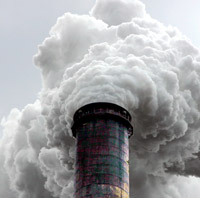 Final coal emission regulations were released September 5, 2012 by the Canadian government. The final regulations indicate coal-fired power plants will be allowed to operate up to 420 tonnes of greenhouse gases per gigawatt hour of electricity generation. This is far higher than 375 tonnes of greenhouse gasses per gigawatt hour Environment Minister Kent originally proposed last August.
Final coal emission regulations were released September 5, 2012 by the Canadian government. The final regulations indicate coal-fired power plants will be allowed to operate up to 420 tonnes of greenhouse gases per gigawatt hour of electricity generation. This is far higher than 375 tonnes of greenhouse gasses per gigawatt hour Environment Minister Kent originally proposed last August."Kent's announcement is a either a bad joke or an insult to the intelligence of Canadians. It's amazing he can make these announcements with a straight face," John Bennett, executive director of Sierra Club Canada, said in a news release. "Coal is the easiest source of greenhouse gases to deal with because cleaner alternatives are already cost-competitive," said Keith Stewart of Greenpeace Canada. "If the federal government is prepared to gut its proposed coal regulations this way, then the oil lobby must be smiling while they sharpen their knives." View September 7, 2012 The Pembina Institute blog postView September 6, 2012 CBC News article View September 6, 2012 The Globe and Mail article View September 5, 2012 Environment Canada news release View September 5, 2012 Climate Action Network Canada article |
|
 Print version Print version |
Top |
| BP Courts Gulf Dark Waters | 11 September 12 |
 New court papers filed by the US Department of Justice (DOJ) charge British Petroleum (BP) with 'gross negligence and willful misconduct ' in their handling of the 2010 Deepwater Horizon oil spill. The new court filing demonstrates the US Department of Justice is ready to take a hard line in a new case against BP slated to begin February 2013 in New Orleans.
New court papers filed by the US Department of Justice (DOJ) charge British Petroleum (BP) with 'gross negligence and willful misconduct ' in their handling of the 2010 Deepwater Horizon oil spill. The new court filing demonstrates the US Department of Justice is ready to take a hard line in a new case against BP slated to begin February 2013 in New Orleans.BP reached a damage settlement with plaintiffs of the Deepwater Horizons disaster back in March 2012. The new Department of Justice filing would quadruple the civil damages BP must pay to $21 billion. "The behavior, words, and actions of these BP executives would not be tolerated in a middling size company manufacturing dry goods for sale in a suburban mall," government lawyers wrote in the filing on August 31 in federal court in New Orleans. View September 5, 2012 Reuters articleView September 5, 2012 Common Dreams article View July 27, 2012 Reuters article View January 27, 2012 The Guardian article View January 26, 2012 BP Press Release View April 20, 2010 The Telegraph article |
|
 Print version Print version |
Top |
| Keeyask EIS Available, Review Period Short | 31 August 12 |
 The environmental impact statement (EIS) for Manitoba Hydro's 695 mega watt Keeyask generation station on the Nelson River in north eastern Manitoba is now in public registries. The full set of materials was filed in registries on August 17. This followed a partial filing in early July, 2012. The deadline for review comments is September 20, 2012. Several thousand pages of assessment and technical reports are included.
The environmental impact statement (EIS) for Manitoba Hydro's 695 mega watt Keeyask generation station on the Nelson River in north eastern Manitoba is now in public registries. The full set of materials was filed in registries on August 17. This followed a partial filing in early July, 2012. The deadline for review comments is September 20, 2012. Several thousand pages of assessment and technical reports are included.The project is also subject to federal review, and an environmental comprehensive report, under the original Canadian Environmental Act. A cooperative federal-provincial environmental assessment has been underway since 2010, with EIS guidelines being issued in March 2012. Manitoba Wildlands participated in the review of the project scoping document, which was used as the basis for EIS guidelines. We have posted updates to our Keeyask contents, see links below. View Keeyask Cooperative Environmental Assessment Process ChartView Keeyask Hydropower Partnership website View Manitoba Wildlands Keeyask page View February 2012, Canadian Environmental Assessment Agency Draft Keeyask EIS Guidelines |
|
 Print version Print version |
Top |
| Bi Pole III Proceedings Stumbling Along | 31 August 12 |
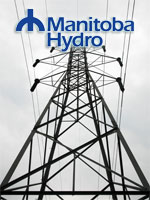 Updates about the proceeding are being posted on Manitoba Wildlands so that interested and affected communities and organizations can follow the proceedings. The Bi Pole III proceedings now overlap between the Environmental Assessment and Licensing Branch (EALB) of Manitoba Conservation and Water Stewardship and the Clean Environment Commission (CEC). CEC proceedings began in May 2012. EALB reviews began in late 2009, and continue during summer 2012 due to late EIS filings from Manitoba Hydro and delays in responses from the utility to formal information requests.
Updates about the proceeding are being posted on Manitoba Wildlands so that interested and affected communities and organizations can follow the proceedings. The Bi Pole III proceedings now overlap between the Environmental Assessment and Licensing Branch (EALB) of Manitoba Conservation and Water Stewardship and the Clean Environment Commission (CEC). CEC proceedings began in May 2012. EALB reviews began in late 2009, and continue during summer 2012 due to late EIS filings from Manitoba Hydro and delays in responses from the utility to formal information requests.Recently participants filed motions to adjourn CEC proceedings until all EIS materials are received, reviewed, and able to be applied to the CEC proceedings. These motions were refused. With EIS materials still outstanding, including in response to formal requests from the Manitoba government licensing branch, the proposed hearings start in early October seems optimistic. Manitoba has begun a multi year pattern of environment act proposals for hydro projects, with public reviews, assessments, and public hearings. These may be scheduled in relation to the assumed in service dates for Bipole III, Keeyask, and other dams, transmission projects, plus sale agreements for exports of hydro electricity. View Manitoba Wildlands Manitoba Hydro Projects: BiPole III CEC Hearings page |
|
 Print version Print version |
Top |
| Meteorologist Statement Confirms Climate Change | 29 August 12 |
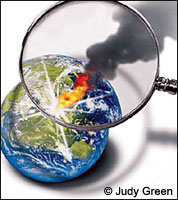 The American Society of Meteorologists (AMS) have adjusted their official stance on Climate change. The AMS Council issued a statement on August 20, 2012 stating;
The American Society of Meteorologists (AMS) have adjusted their official stance on Climate change. The AMS Council issued a statement on August 20, 2012 stating;'There is unequivocal evidence that Earth's lower atmosphere, ocean, and land surface are warming; sea level is rising; and snow cover, mountain glaciers, and Arctic sea ice are shrinking. The dominant cause of the warming since the 1950s is human activities. This scientific finding is based on a large and persuasive body of research.' The AMS is currently supporting a campaign to educate the public and the media on the subject of climate change. A recent survey of weather forecasters in the US showed a distinct lack of understanding of climate change and more than a 50% denial rate of climate change. The AMS is citing this lack of understanding and belief in scientific research as the reason why public opinion and US policy continues to turn a blind eye to impacts human activity is having when it comes to climate change. View August 2012 American Meteorological Society reportView August 28, 2012 Summit County Citizens Voice article View August 28, 2012 Common Dreams article View Forecast the Facts Weather Caster Watch page View August 21, 2012 Grist article |
|
 Print version Print version |
Top |
| Lower Athabasca Plan Falls Short | 29 August 12 |
 The Lower Athabasca Regional Plan (LARP) was released late August 2012, and its attempts to address the cumulative impacts of oil and gas developments and conservation needs were clearly missing. The LARPS leaves First Nation participation, rights, title and community knowledge out of its design. Athabascan Chipewyan First Nation (ACFN), whose traditional lands are full or tar sand development, has been in dialogue with the Alberta government for a year to deal with staggering concerns the ACFN have raised regarding development. Organizations monitoring the LARP process have questioned process and the integrity of understanding demonstrated by Alberta's government.
The Lower Athabasca Regional Plan (LARP) was released late August 2012, and its attempts to address the cumulative impacts of oil and gas developments and conservation needs were clearly missing. The LARPS leaves First Nation participation, rights, title and community knowledge out of its design. Athabascan Chipewyan First Nation (ACFN), whose traditional lands are full or tar sand development, has been in dialogue with the Alberta government for a year to deal with staggering concerns the ACFN have raised regarding development. Organizations monitoring the LARP process have questioned process and the integrity of understanding demonstrated by Alberta's government."Your plan, your land, your future? This is not our plan it's the governments plan to annihilate our lands and our future. There are no commitments to our people and no protection of our lands and rights. We thought we were working towards a partnership with the government, but this plan doesn't reflect that," states Chief Allan Adam of ACFN. "The plan's management framework is riddled with significant gaps and it gives far too much discretion to government decision-makers," said Barry Robinson, Ecojustice staff lawyer. "Until those gaps are addressed and a better regulatory system is installed, the Alberta government shouldn't approve any further oilsands developments in the area." View August 24, 2012 Athabasca Chipewyan First Nation News ReleaseView Government of Alberta Lower Athabasca Regional Plan View Lower Athabasca Regional Plan (LARP) performance backgrounder View May 17, 2011 Ecojustice News Release View August 22, 2012 The Globe and Mail article View Recommended Conservation Approach for the Lower Athabasca Regional Plan |
|
 Print version Print version |
Top |
| Government Cancels 3,000 Environmental Reviews | 24 August 12 |
 Canada cancelled 2,970 screenings of potential environmental damage from a wide variety of proposed development projects July 6, 2012. The cancelled environmental reviews include coastal seismic testing, considered to be harmful to marine species, as well as a controversial proposal to reverse an Enbridge pipeline, and the construction of a new crude oil terminal and pipeline infrastructure for TransCanada's Keystone route.
Canada cancelled 2,970 screenings of potential environmental damage from a wide variety of proposed development projects July 6, 2012. The cancelled environmental reviews include coastal seismic testing, considered to be harmful to marine species, as well as a controversial proposal to reverse an Enbridge pipeline, and the construction of a new crude oil terminal and pipeline infrastructure for TransCanada's Keystone route."If you care about clean air, fresh water and wild salmon you should be very, very concerned," said Gwen Barlee, Wilderness Committee policy director. "It's death by a thousand cuts. All these little projects are destroying habitat and Ottawa is ignoring that," said Otto Langer, retired head of habitat assessment and planning for the federal fisheries department in B.C. The cancelled reviews are a direct result of the Government of Canada's omnibus budget bill, which passed May 2012, modifying or replacing 69 pieces of legislation. This included completely replacing the Canadian Environmental Assessment Act. "Sadly in Canada right now when the oil industry says jump, the government asks how high," said Hannah McKinnon, campaign director of Climate Action Network Canada, a coalition of environmental, labour union and faith-based groups. The number of environmental reviews cancelled in each Canadian province are as follows: Alberta (348), British Columbia (492), Manitoba (87), New Brunswick (141), Newfoundland and Labrador (152), Northwest Territories (6), Nova Scotia (151), Nunavut (1), Ontario (561), PEI (24), Quebec (295), Saskatchewan (638), Yukon (1). View August 23, 2012 Postmedia News coverageView August 23, 2012 Ottawa Citizen coverage View August 22, 2012 Vancouver Sun coverage View August 22, 2012 Postmedia News Coverage View Canadian Environmental Assessment Agency Screenings Cancelled in July 2012 page View Canadian Environmental Assessment Agency Screenings Cancelled in May 2012 page View August 24, 2012 Times Colonist article View August 29, 2012 Toronto Star article
Sources: Postmedia News, Vancouver Sun
|
|
 Print version Print version |
Top |
| 2012 Planetary Capacity Used Up | 24 August 12 |
 Earth Overshoot Day, the day humanity uses the annual capacity of the planet to renew or regrow, occurred on August 22, 2012. For the rest of the year, we accumulate debt by depleting natural capital and resources, and letting waste accumulate.
Earth Overshoot Day, the day humanity uses the annual capacity of the planet to renew or regrow, occurred on August 22, 2012. For the rest of the year, we accumulate debt by depleting natural capital and resources, and letting waste accumulate.Global Footprint Network (GFN), a California-based environmental research organization assesses Earth Overshoot Day each year. They calculate humanity currently uses more than 1.5 times the Earth's regenerative capacity in a year. "Overshoot can be thought of as living off your credit card. Humanity is living off its ecological credit card," explains Global Footprint Network Associate Director Susan Burns. Throughout most of history, humanity has stayed within the planet's carrying capacity. But since the mid 1970's, we've been using more resources than can be replenished, meaning we keep going deeper and deeper into the hole. Each year, "Earth Overshoot Day" comes sooner. In 1992 GFN estimated that Earth Overshoot Day fell on October 21, by 2002 it was October 3, and by 2009 it was September 25. If current trends continue unchanged, we are on track to require the annual resources of two planets well before 2050. "Our ecological overspending has become a vicious cycle, in which we draw down more and more principal at the same time our level of consumption, or "spending," grows. The social and economic costs could be staggering," said Dr. Mathis Wackernagel, Global Footprint Network President. View August 22, 2012 Global Footprint Network Earth Overshoot Day pageView August 22, 2012 Global Footprint Network press release View August 22, 2012 Best Foot Forward coverage View August 22, 2012 International Council for Local Environmental Initiatives page View August 22, 2012 Population Matters coverage View August 21, 2012 Grist coverage Watch August 13, 2012 What Is Ecological Overshoot? video View August 27, 2010 Manitoba Wildlands Earth Overshoot coverage View October 9, 2009 Manitoba Wildlands Earth Overshoot coverage
Source: Global Footprint Network
|
|
 Print version Print version |
Top |
| New National Park Reserve Lacking | 24 August 12 |
 On August 22nd, Canada established a new National Park Reserve. Nááts'ihch'oh National Park Reserve covers 4,850 square kilometers and protects a great part of the Nahanni watershed. In the press release regarding the Nááts'ihch'oh National Park Reserve, the Canadian governments states that; 'This completes the federal government's work in protecting the Greater Nahanni Ecosystem for future generations.'
On August 22nd, Canada established a new National Park Reserve. Nááts'ihch'oh National Park Reserve covers 4,850 square kilometers and protects a great part of the Nahanni watershed. In the press release regarding the Nááts'ihch'oh National Park Reserve, the Canadian governments states that; 'This completes the federal government's work in protecting the Greater Nahanni Ecosystem for future generations.'Stephen Kakfwi, former premier of the Northwest Territories is disappointed with the way the boundary lines are drawn. He said in an interview that Prime Minister Harper is protecting the mining interests more than environmental interests. "Unfortunately I think Prime Minister Harper has let down Canadians in his choice," Kakfwi said. "That is not a national park, that is a joke." He went on to say that local people were put in a corner because it was either the smaller protected area than they desired, or no protection at all. The boundaries of the new park reserve do not reflect scientific research or the overwhelming support from Canadians to protect the headwaters of the Nahanni watershed and critical wildlife habitat within. Park Reserves are added to the schedule on Natural Park Act, and approved by the House of Commons and Senate. View August 23, 2012 CBC News articleView August 22, 2012 CBC News article View August 22, 2012 CBC News article View August 22, 2012 CPAWS article View August 22, 2012 Parks Canada News Release View August 22, 2012 CTV News article |
|
 Print version Print version |
Top |
| Wacky Weather: Winnipeg's Warmest Year Ever Recorded | 17 August 12 |
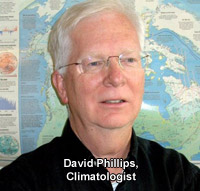 According to David Phillips, senior climatologist with Environment Canada, Winnipeg has just set a record for the warmest 12-month period since weather records for Winnipeg started 140 years ago.
According to David Phillips, senior climatologist with Environment Canada, Winnipeg has just set a record for the warmest 12-month period since weather records for Winnipeg started 140 years ago."I looked at every combination of 12 months from September through August, January to December, March through to February. There never has been a warmer 12 months in [Winnipeg's] recorded history," Phillips said. The average temperature in Winnipeg between Aug. 1, 2011 and Jul. 31, 2012 was 6 °C (43 °F). This shatters the record of 5.6 °C (42 °F) that stood since 1877, and is well above Winnipeg's historical median temperature of 2.6 °C (37 °F). The average temperature included highest and lowest each 24 hours, through all seasons. Winnipeg is not the only place experiencing unusually warm weather. The Mojave Desert town of Needles, California, experienced rainfall that fell to the ground at a scorching 46.1 °C (115 °F) on August 13, 2012 – the hottest rainfall ever recorded on the planet. In Phoenix, Arizona, residents dealt with nine straight days (August 6th to 14th, 2012) with the mercury above 43 °C (110 °F). "It's becoming very hard to not conclude that global warming is decidedly here, especially with the extreme events and the record runs like the one we've just experienced," said Dr. Danny Blair, the associate dean of science and director of the Climate Studies Institute at the University of Winnipeg. Blair said weather patterns are largely determined by jet streams -- and these streams are affected when the patterns of the Earth's surface change. View August 9, 2012 Winnipeg Free Press coverageListen August 9, 2012 CBC Radio coverage View August 14, 2012 New York Times coverage View August 15, 2012 Treehugger coverage View August 15, 2012 Treehugger coverage View August 15, 2012 Dr. Jeff Masters Blog post on WunderGround.com Sources:
Winnipeg Free Press, CBC, Treehugger
|
|
 Print version Print version |
Top |
| Arctic Ice Cap Disappearing | 17 August 12 |
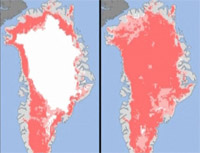 Arctic sea ice is melting at a pace 50 per cent faster than once thought, and the latest projections say it might disappear by as soon as 2022, according to measurements from the European Space Agency. The satellite estimates were cross-referenced with data obtained from NASA planes flying over the Arctic and submarines making sonar measurements from beneath the ice.
Arctic sea ice is melting at a pace 50 per cent faster than once thought, and the latest projections say it might disappear by as soon as 2022, according to measurements from the European Space Agency. The satellite estimates were cross-referenced with data obtained from NASA planes flying over the Arctic and submarines making sonar measurements from beneath the ice.About 7,000 cubic kilometres of ice remained at the end of last summer. By contrast, in 2004 there was 13,000 cubic km of sea ice in the Arctic. "Very soon we may experience the iconic moment when, one day in the summer, we look at satellite images and see no sea ice coverage in the Arctic, just open water," said Dr. Seymour Laxon, with London's Centre for Polar Observation and Modelling. The consequences of losing Arctic ice coverage, even for only part of the year, could be profound. The ice caps reflect sunlight back into space, without them the region will heat up even more than at present. As a result, ocean temperatures will rise and methane deposits could melt, evaporate and bubble into the atmosphere. Methane is a particularly powerful greenhouse gas and rising levels in the atmosphere are likely to accelerate global warming. "Our greatest concern is that loss of Arctic sea ice creates a grave threat of passing two other tipping points -- the potential instability of the Greenland ice sheet and methane hydrates. These latter two tipping points would have consequences that are practically irreversible on time scales of relevance to humanity," said NASA's top climate scientist, James Hansen. View August 17, 2012 Bloomberg coverageView August 13, 2012 CBC coverage View August 11, 2012 Guardian coverage View July 25, 2012 PBS coverage View July 25, 2012 IBTimes TV coverage View University of Colorado National Snow & Ice Data Center, Arctic Sea Ice News Analysis page View August 21, 2012 PlanetArk article |
|
 Print version Print version |
Top |
| Drought Creates Ethanol & Food Conflict | 17 August 12 |
 A drought and heatwave in the US Midwest has destroyed the US corn crop. The US, historically the world's largest corn producer, is expecting half the ordinary corn yields per acre. The crop failure is driving up prices and threatening an international food crisis.
A drought and heatwave in the US Midwest has destroyed the US corn crop. The US, historically the world's largest corn producer, is expecting half the ordinary corn yields per acre. The crop failure is driving up prices and threatening an international food crisis.Governments must act to prevent a global food crisis that may "hit us very soon," said Shenggen Fan, director-general of the International Food Policy Research Institute. The United Nations (UN) Food and Agriculture Organization (FAO) has called on the United States to suspend the mandate that results in 40% of the corn going to make biofuel. Suspension of the quota would allow more of the crop to go for food production. "With world prices of cereals rising, the competition between the food, feed and fuel sectors for crops such as maize, sugar and oilseeds is likely to intensify. One way to alleviate some of the tension would be to lower or temporarily suspend the mandates on biofuels," stated Jose Graziano da Silva, director general of the UN FAO. The US Renewable Fuels Standard, or RFS, has long been controversial, with many blaming the quota for pushing up corn prices. The RFS requires 13.2 billion gallons of ethanol to be made from corn in 2012. The United Nations and Food Policy Research Institute are not alone in calling for the US quota to be suspended. Livestock producers in the US, worried about the cost of cattle feed, also want it scrapped and the governments of China, India and France have expressed concerns about the policy. View August 17, 2012 Canada Free Press coverageView August 17, 2012 Friends of the Earth release View August 16, 2012 Bloomberg coverage View August 14, 2012 Reuters coverage View August 10, 2012 BBC coverage View August 9, 2012 Financial Times coverage View August 21, 2012 PlanetArk article Sources:
BBC, Bloomberg, Financial Times
|
|
 Print version Print version |
Top |


 RSS Feeds:
RSS Feeds: